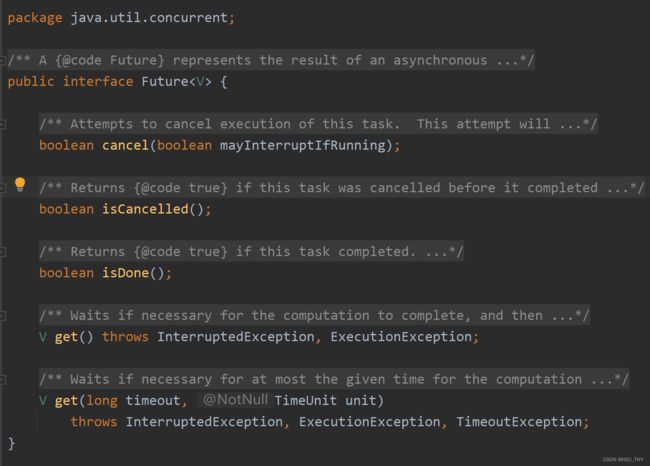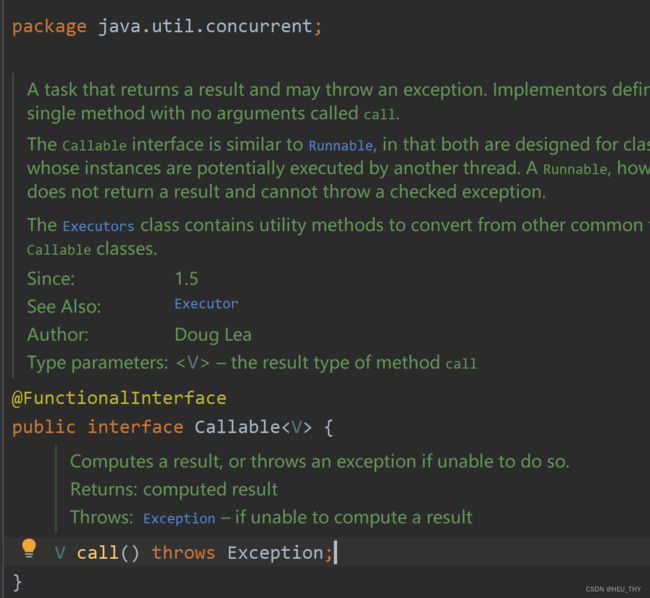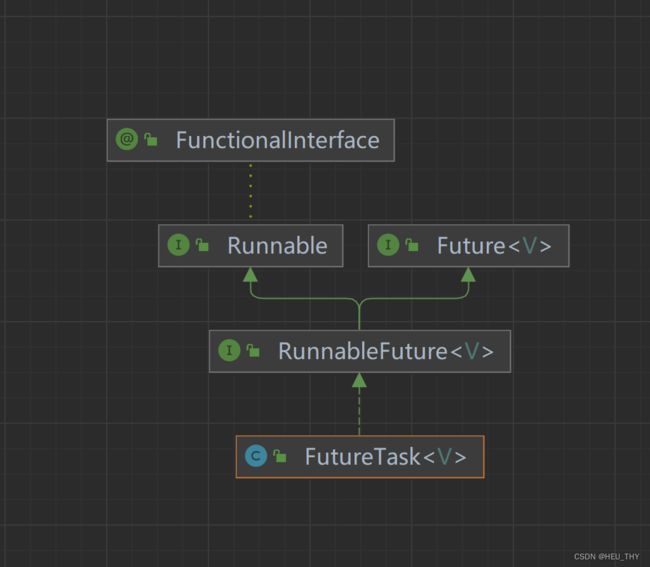JUC高并发编程之CompletableFuture
1、Future和Callable接口
Future接口定义了操作异步任务执行一些方法,如获取异步任务的执行结果、取消任务的执行、判断任务是否被取消、判断任务执行是否完毕等。

Callable接口中定义了需要有返回的任务需要实现的方法

为什么使用异步任务?
当主线程让一个子线程去执行任务,子线程可能比较耗时,启动子线程开始执行任务后,主线程就去做其他事情了,过了一会才去获取子任务的执行结果。
2、FutureTask
2.1、get()阻塞
public class CompletableFutureDemo{
public static void main(String[] args) throws ExecutionException, InterruptedException, TimeoutException{
FutureTask<String> futureTask = new FutureTask<>(() -> {
System.out.println("-----come in FutureTask");
try { TimeUnit.SECONDS.sleep(3); } catch (InterruptedException e) { e.printStackTrace(); }
return ThreadLocalRandom.current().nextInt(100);
});
Thread t1 = new Thread(futureTask,"t1");
t1.start();
//3秒钟后才出来结果,还没有计算你提前来拿(只要一调用get方法,对于结果就是不见不散,会导致阻塞)
//System.out.println(Thread.currentThread().getName()+"\t"+futureTask.get());
//3秒钟后才出来结果,我只想等待1秒钟,过时不候
System.out.println(Thread.currentThread().getName()+"\t"+futureTask.get(1L,TimeUnit.SECONDS));
System.out.println(Thread.currentThread().getName()+"\t"+" run... here");
}
}
- get()阻塞 一旦调用get()方法,不管是否计算完成都会导致阻塞
2.2、isDone()轮询
public class CompletableFutureDemo2 {
public static void main(String[] args) throws ExecutionException, InterruptedException {
FutureTask<String> futureTask = new FutureTask<>(() -> {
System.out.println("-----come in FutureTask");
try { TimeUnit.SECONDS.sleep(3); } catch (InterruptedException e) { e.printStackTrace(); }
return ""+ ThreadLocalRandom.current().nextInt(100);
});
new Thread(futureTask,"t1").start();
System.out.println(Thread.currentThread().getName()+"\t"+"线程完成任务");
/**
* 用于阻塞式获取结果,如果想要异步获取结果,通常都会以轮询的方式去获取结果
*/
while (true){
if(futureTask.isDone()){
System.out.println(futureTask.get());
break;
}
}
}
}
- isDone()轮询
轮询的方式会耗费无谓的CPU资源,而且也不见得能及时地得到计算结果。
如果想要异步获取结果,通常都会以轮询的方式去获取结果。
3、类CompletableFuture(Future的改进)
3.1、CompletableFuture介绍
-
阻塞的方式和异步编程的设计理念相违背,而轮询的方式会消耗无畏的CPU资源。因此,JDK8设计出CompletableFuture。

-
在Java 8中, Complet able Future提供了非常强大的Future的扩展功能, 可以帮助我们简化异步编程的复杂性,并且提供了函数式编程的能 力, 可以通过回调的方式处理计算结果, 也提供了转换和组合Complet able Future的方法。
-
它可能代表一个明确完成的Future, 也有可能代表一个完成阶段(Completion Stage),它支持在计算完成以后触发一些函数或执行某些 动作。
-
它实现了Future和Completion Stage接口。
3.2、CompletionStage
- Completion Stage代表异步计算过程中的某一个阶段, 一个阶段完成以后可能会触发另外一个阶段。
- 一个阶段的计算执行可以是一个Function, Consumer或者Runnable。比如:
stage.thenApply(x->square(x)).thenAccept(x->System.out.print(x)).thenRun() ->System.out.print In()),一个阶段的执行可能是被单个阶段的完成触发,也可能是由多个阶段一起触发。
4、核心的四个静态方法
4.1、runAsync 无 返回值
public static CompletableFuture<Void> runAsync(Runnable runnable)
public static CompletableFuture<Void> runAsync(Runnable runnable,Executor executor)
4.2、supplyAsync 有 返回值
public static <U> CompletableFuture<U> supplyAsync(Supplier<U> supplier)
public static <U> CompletableFuture<U> supplyAsync(Supplier<U> supplier,Executor executor)
上述Executor executor参数说明
没有指定Executor的方法,直接使用默认的ForkJoinPool.commonPool() 作为它的线程池执行异步代码。
如果指定线程池,则使用我们自定义的或者特别指定的线程池执行异步代码
4.3、Code 无 返回值
public class CompletableFutureDemo3{
public static void main(String[] args) throws ExecutionException, InterruptedException{
CompletableFuture<Void> future = CompletableFuture.runAsync(() -> {
System.out.println(Thread.currentThread().getName()+"\t"+"-----come in");
//暂停几秒钟线程
try { TimeUnit.SECONDS.sleep(1); } catch (InterruptedException e) { e.printStackTrace(); }
System.out.println("-----task is over");
});
System.out.println(future.get());
}
}
4.4、Code 有 返回值
public class CompletableFutureDemo3{
public static void main(String[] args) throws ExecutionException, InterruptedException{
CompletableFuture<Integer> completableFuture = CompletableFuture.supplyAsync(() -> {
System.out.println(Thread.currentThread().getName() + "\t" + "-----come in");
//暂停几秒钟线程
try {
TimeUnit.SECONDS.sleep(1);
} catch (InterruptedException e) {
e.printStackTrace();
}
return ThreadLocalRandom.current().nextInt(100);
});
System.out.println(completableFuture.get());
}
}
4.5、Code 减少阻塞和轮询
从Java8开始引入了CompletableFuture,它是Future的功能增强版,可以传入回调对象,当异步任务完成或者发生异常时,自动调用回调对象的回调方法
public class CompletableFutureDemo3{
public static void main(String[] args) throws Exception{
CompletableFuture<Integer> completableFuture = CompletableFuture.supplyAsync(() -> {
System.out.println(Thread.currentThread().getName() + "\t" + "-----come in");
int result = ThreadLocalRandom.current().nextInt(10);
//暂停几秒钟线程
try { TimeUnit.SECONDS.sleep(1); } catch (InterruptedException e) { e.printStackTrace(); }
System.out.println("-----计算结束耗时1秒钟,result: "+result);
if(result > 6){
int age = 10/0;
}
return result;
}).whenComplete((v,e) ->{
if(e == null){
System.out.println("-----result: "+v);
}
}).exceptionally(e -> {
System.out.println("-----exception: "+e.getCause()+"\t"+e.getMessage());
return -44;
});
//主线程不要立刻结束,否则CompletableFuture默认使用的线程池会立刻关闭:暂停3秒钟线程
try { TimeUnit.SECONDS.sleep(3); } catch (InterruptedException e) { e.printStackTrace(); }
}
}
4.6、CompletableFuture的优点
异步任务结束时,会自动回调某个对象的方法;
异步任务出错时,会自动回调某个对象的方法;
主线程设置好回调后,不再关心异步任务的执行,异步任务之间可以顺序执行。
5、join和get对比
-
功能几乎一样,区别在于编码时是否需要抛出异常
get()方法需要抛出异常 join()方法不需要抛出异常
6、案例-电商网站的价格对比
经常出现在等待某条 SQL 执行完成后,再继续执行下一条 SQL ,而这两条 SQL 本身是并无关系的,可以同时进行执行的。我们希望能够两条 SQL 同时进行处理,而不是等待其中的某一条 SQL 完成后,再继续下一条。同理,对于分布式微服务的调用,按照实际业务,如果是无关联step by step的业务,可以同时调用。如查看同一个商品在各个平台上的价格,要求获得一个清单列表。
- step by step,查完京东查淘宝,查完淘宝查天猫…
- all 一口气同时查询。。。。。
import lombok.Getter;
import java.util.Arrays;
import java.util.List;
import java.util.concurrent.CompletableFuture;
import java.util.concurrent.ThreadLocalRandom;
import java.util.concurrent.TimeUnit;
import java.util.stream.Collectors;
public class T1{
static List<NetMall> list = Arrays.asList(
new NetMall("jd"),
new NetMall("tmall"),
new NetMall("pdd"),
new NetMall("mi")
);
public static List<String> findPriceSync(List<NetMall> list,String productName){
return list.stream().map(mall -> String.format(productName+" %s price is %.2f",mall.getNetMallName(),mall.getPriceByName(productName))).collect(Collectors.toList());
}
public static List<String> findPriceASync(List<NetMall> list,String productName){
return list.stream().map(mall -> CompletableFuture.supplyAsync(() -> String.format(productName + " %s price is %.2f", mall.getNetMallName(), mall.getPriceByName(productName)))).collect(Collectors.toList()).stream().map(CompletableFuture::join).collect(Collectors.toList());
}
public static void main(String[] args){
long startTime = System.currentTimeMillis();
List<String> list1 = findPriceSync(list, "thinking in java");
for (String element : list1) {
System.out.println(element);
}
long endTime = System.currentTimeMillis();
System.out.println("----costTime: "+(endTime - startTime) +" 毫秒");
long startTime2 = System.currentTimeMillis();
List<String> list2 = findPriceASync(list, "thinking in java");
for (String element : list2) {
System.out.println(element);
}
long endTime2 = System.currentTimeMillis();
System.out.println("----costTime: "+(endTime2 - startTime2) +" 毫秒");
}
}
class NetMall{
@Getter
private String netMallName;
public NetMall(String netMallName){
this.netMallName = netMallName;
}
public double getPriceByName(String productName){
return calcPrice(productName);
}
private double calcPrice(String productName){
try { TimeUnit.SECONDS.sleep(1); } catch (InterruptedException e) { e.printStackTrace(); }
return ThreadLocalRandom.current().nextDouble() + productName.charAt(0);
}
}
7、CompletableFuture常用方法
7.1、获得结果和触发计算(get)
- 获取结果
// 不见不散
public T get()
// 过时不候
public T get(long timeout, TimeUnit unit)
// 没有计算完成的情况下,给我一个替代结果
// 立即获取结果不阻塞 计算完,返回计算完成后的结果 没算完,返回设定的valueIfAbsent值
public T getNow(T valueIfAbsent)
public class CompletableFutureDemo2{
public static void main(String[] args) throws ExecutionException, InterruptedException{
CompletableFuture<Integer> completableFuture = CompletableFuture.supplyAsync(() -> {
try { TimeUnit.SECONDS.sleep(1); } catch (InterruptedException e) { e.printStackTrace(); }
return 533;
});
//去掉注释上面计算没有完成,返回444
//开启注释上满计算完成,返回计算结果
try { TimeUnit.SECONDS.sleep(2); } catch (InterruptedException e) { e.printStackTrace(); }
System.out.println(completableFuture.getNow(444));
}
}
public T join()
public class CompletableFutureDemo2{
public static void main(String[] args) throws ExecutionException, InterruptedException{
System.out.println(CompletableFuture.supplyAsync(() -> "abc").thenApply(r -> r + "123").join());
}
}
- 主动触发计算
// 是否打断get方法立即返回括号值
public boolean complete(T value)
public class CompletableFutureDemo4{
public static void main(String[] args) throws ExecutionException, InterruptedException{
CompletableFuture<Integer> completableFuture = CompletableFuture.supplyAsync(() -> {
try { TimeUnit.SECONDS.sleep(1); } catch (InterruptedException e) { e.printStackTrace(); }
return 533;
});
//注释掉暂停线程,get还没有算完只能返回complete方法设置的444;暂停2秒钟线程,异步线程能够计算完成返回get
try { TimeUnit.SECONDS.sleep(2); } catch (InterruptedException e) { e.printStackTrace(); }
//当调用CompletableFuture.get()被阻塞的时候,complete方法就是结束阻塞并get()获取设置的complete里面的值.
System.out.println(completableFuture.complete(444)+"\t"+completableFuture.get());
}
}
7.2、对计算结果进行处理(thenApply、handle)
thenApply
// 计算结果存在依赖关系,这两个线程串行化
// 由于存在依赖关系(当前步错,不走下一步),当前步骤有异常的话就叫停。
public class CompletableFutureDemo4{
public static void main(String[] args) throws ExecutionException, InterruptedException{
//当一个线程依赖另一个线程时用 thenApply 方法来把这两个线程串行化,
CompletableFuture.supplyAsync(() -> {
//暂停几秒钟线程
try { TimeUnit.SECONDS.sleep(1); } catch (InterruptedException e) { e.printStackTrace(); }
System.out.println("111");
return 1024;
}).thenApply(f -> {
System.out.println("222");
return f + 1;
}).thenApply(f -> {
//int age = 10/0; // 异常情况:那步出错就停在那步。
System.out.println("333");
return f + 1;
}).whenCompleteAsync((v,e) -> {
System.out.println("*****v: "+v);
}).exceptionally(e -> {
e.printStackTrace();
return null;
});
System.out.println("-----主线程结束,END");
// 主线程不要立刻结束,否则CompletableFuture默认使用的线程池会立刻关闭:
try { TimeUnit.SECONDS.sleep(2); } catch (InterruptedException e) { e.printStackTrace(); }
}
}
handle
// 有异常也可以往下一步走,根据带的异常参数可以进一步处理
public class CompletableFutureDemo4{
public static void main(String[] args) throws ExecutionException, InterruptedException{
//当一个线程依赖另一个线程时用 handle 方法来把这两个线程串行化,
// 异常情况:有异常也可以往下一步走,根据带的异常参数可以进一步处理
CompletableFuture.supplyAsync(() -> {
//暂停几秒钟线程
try { TimeUnit.SECONDS.sleep(1); } catch (InterruptedException e) { e.printStackTrace(); }
System.out.println("111");
return 1024;
}).handle((f,e) -> {
int age = 10/0;
System.out.println("222");
return f + 1;
}).handle((f,e) -> {
System.out.println("333");
return f + 1;
}).whenCompleteAsync((v,e) -> {
System.out.println("*****v: "+v);
}).exceptionally(e -> {
e.printStackTrace();
return null;
});
System.out.println("-----主线程结束,END");
// 主线程不要立刻结束,否则CompletableFuture默认使用的线程池会立刻关闭:
try { TimeUnit.SECONDS.sleep(2); } catch (InterruptedException e) { e.printStackTrace(); }
}
}
7.3、对计算结果进行消费(thenAccept、thenRun)
接收任务的处理结果,并消费处理,无返回结果
//thenAccept
public static void main(String[] args) throws ExecutionException, InterruptedException{
CompletableFuture.supplyAsync(() -> {
return 1;
}).thenApply(f -> {
return f + 2;
}).thenApply(f -> {
return f + 3;
}).thenApply(f -> {
return f + 4;
}).thenAccept(r -> System.out.println(r));
}
Code之任务之间的顺序执行
thenRun
thenRun(Runnable runnable)
// 任务 A 执行完执行 B,并且 B 不需要 A 的结果
thenAccept
thenAccept(Consumer action)
// 任务 A 执行完执行 B,B 需要 A 的结果,但是任务 B 无返回值
thenApply
thenApply(Function fn)
// 任务 A 执行完执行 B,B 需要 A 的结果,同时任务 B 有返回值
System.out.println(CompletableFuture.supplyAsync(() -> "resultA").thenRun(() -> {}).join());
System.out.println(CompletableFuture.supplyAsync(() -> "resultA").thenAccept(resultA -> {}).join());
System.out.println(CompletableFuture.supplyAsync(() -> "resultA").thenApply(resultA -> resultA + " resultB").join());
7.4、CompleteFuture和线程池说明
-
上面的几个方法都有普通版本和后面加Async的版本
-
以thenRun和thenRunAsync为例,有什么区别?
-
先看结论
1、没有传入自定义线程池,都用默认线程池ForkJoinPool 2、传入了一个自定义线程池如果你执行第一个任务的时候,传入了一个自定义线程池 调用thenRun方法执行第二个任务的时候,则第二个任务和第一个任务是用同一个线程池 调用thenRunAsync执行第二个任务的时候,则第一个任务使用的是你自己传入的线程池,第二个任务使用的是ForkJoin线程池 3、也有可能处理太快,系统优化切换原则,直接使用main线程处理(把sleep去掉)
//2-1
public class CompletableFutureAPIDemo {
public static void main(String[] args) throws ExecutionException, InterruptedException {
ExecutorService threadPool = Executors.newFixedThreadPool(5);
CompletableFuture<Void> completableFuture = CompletableFuture.supplyAsync(()->{
try {TimeUnit.MILLISECONDS.sleep(20);} catch (InterruptedException e) {e.printStackTrace();}
System.out.println("1号任务"+"\t"+Thread.currentThread().getName());
return "abcd";
},threadPool).thenRun(()->{
try {TimeUnit.MILLISECONDS.sleep(20);} catch (InterruptedException e) {e.printStackTrace();}
System.out.println("2号任务"+"\t"+Thread.currentThread().getName());
}).thenRun(()->{
try {TimeUnit.MILLISECONDS.sleep(20);} catch (InterruptedException e) {e.printStackTrace();}
System.out.println("3号任务"+"\t"+Thread.currentThread().getName());
}).thenRun(()->{
try {TimeUnit.MILLISECONDS.sleep(20);} catch (InterruptedException e) {e.printStackTrace();}
System.out.println("4号任务"+"\t"+Thread.currentThread().getName());
});
}
}
//1号任务 pool-1-thread-1
//2号任务 pool-1-thread-1
//3号任务 pool-1-thread-1
//4号任务 pool-1-thread-1
//2-2
public class CompletableFutureAPIDemo {
public static void main(String[] args) throws ExecutionException, InterruptedException {
ExecutorService threadPool = Executors.newFixedThreadPool(5);
CompletableFuture<Void> completableFuture = CompletableFuture.supplyAsync(()->{
try {TimeUnit.MILLISECONDS.sleep(20);} catch (InterruptedException e) {e.printStackTrace();}
System.out.println("1号任务"+"\t"+Thread.currentThread().getName());
return "abcd";
},threadPool).thenRunAsync(()->{
try {TimeUnit.MILLISECONDS.sleep(20);} catch (InterruptedException e) {e.printStackTrace();}
System.out.println("2号任务"+"\t"+Thread.currentThread().getName());
}).thenRun(()->{
try {TimeUnit.MILLISECONDS.sleep(20);} catch (InterruptedException e) {e.printStackTrace();}
System.out.println("3号任务"+"\t"+Thread.currentThread().getName());
}).thenRun(()->{
try {TimeUnit.MILLISECONDS.sleep(20);} catch (InterruptedException e) {e.printStackTrace();}
System.out.println("4号任务"+"\t"+Thread.currentThread().getName());
});
}
}
//1号任务 pool-1-thread-1
//2号任务 ForkJoinPool.commonPool-worker-9---这里另起炉灶重新调用了默认的ForkJoinPool
//3号任务 ForkJoinPool.commonPool-worker-9
//4号任务 ForkJoinPool.commonPool-worker-9
public class CompletableFutureAPIDemo {
public static void main(String[] args) throws ExecutionException, InterruptedException {
ExecutorService threadPool = Executors.newFixedThreadPool(5);
CompletableFuture<Void> completableFuture = CompletableFuture.supplyAsync(()->{
// try {TimeUnit.MILLISECONDS.sleep(20);} catch (InterruptedException e) {e.printStackTrace();}
System.out.println("1号任务"+"\t"+Thread.currentThread().getName());
return "abcd";
},threadPool).thenRun(()->{
// try {TimeUnit.MILLISECONDS.sleep(20);} catch (InterruptedException e) {e.printStackTrace();}
System.out.println("2号任务"+"\t"+Thread.currentThread().getName());
}).thenRun(()->{
// try {TimeUnit.MILLISECONDS.sleep(20);} catch (InterruptedException e) {e.printStackTrace();}
System.out.println("3号任务"+"\t"+Thread.currentThread().getName());
}).thenRun(()->{
//try {TimeUnit.MILLISECONDS.sleep(20);} catch (InterruptedException e) {e.printStackTrace();}
System.out.println("4号任务"+"\t"+Thread.currentThread().getName());
});
}
}
//1号任务 1号任务 pool-1-thread-1
//2号任务 main
//3号任务 main
//4号任务 main
7.5、对计算速度进行选用(applyToEither)
谁快用谁
public class CompletableFutureDemo5{
public static void main(String[] args) throws ExecutionException, InterruptedException{
CompletableFuture<Integer> completableFuture1 = CompletableFuture.supplyAsync(() -> {
System.out.println(Thread.currentThread().getName() + "\t" + "---come in ");
//暂停几秒钟线程
try { TimeUnit.SECONDS.sleep(2); } catch (InterruptedException e) { e.printStackTrace(); }
return 10;
});
CompletableFuture<Integer> completableFuture2 = CompletableFuture.supplyAsync(() -> {
System.out.println(Thread.currentThread().getName() + "\t" + "---come in ");
try { TimeUnit.SECONDS.sleep(1); } catch (InterruptedException e) { e.printStackTrace(); }
return 20;
});
CompletableFuture<Integer> thenCombineResult = completableFuture1.applyToEither(completableFuture2,f -> {
System.out.println(Thread.currentThread().getName() + "\t" + "---come in ");
return f + 1;
});
System.out.println(Thread.currentThread().getName() + "\t" + thenCombineResult.get());
}
}
7.6、对计算结果进行合并(thenCombine)
两个CompletionStage任务都完成后,最终能把两个任务的结果一起交给thenCombine 来处理
先完成的先等着,等待其它分支任务
public class CompletableFutureDemo2{
public static void main(String[] args) throws ExecutionException, InterruptedException{
CompletableFuture<Integer> completableFuture1 = CompletableFuture.supplyAsync(() -> {
System.out.println(Thread.currentThread().getName() + "\t" + "---come in ");
return 10;
});
CompletableFuture<Integer> completableFuture2 = CompletableFuture.supplyAsync(() -> {
System.out.println(Thread.currentThread().getName() + "\t" + "---come in ");
return 20;
});
CompletableFuture<Integer> thenCombineResult = completableFuture1.thenCombine(completableFuture2, (x, y) -> {
System.out.println(Thread.currentThread().getName() + "\t" + "---come in ");
return x + y;
});
System.out.println(thenCombineResult.get());
}
}
code表达式
public class CompletableFutureDemo6{
public static void main(String[] args) throws ExecutionException, InterruptedException{
CompletableFuture<Integer> thenCombineResult = CompletableFuture.supplyAsync(() -> {
System.out.println(Thread.currentThread().getName() + "\t" + "---come in 1");
return 10;
}).thenCombine(CompletableFuture.supplyAsync(() -> {
System.out.println(Thread.currentThread().getName() + "\t" + "---come in 2");
return 20;
}), (x,y) -> {
System.out.println(Thread.currentThread().getName() + "\t" + "---come in 3");
return x + y;
}).thenCombine(CompletableFuture.supplyAsync(() -> {
System.out.println(Thread.currentThread().getName() + "\t" + "---come in 4");
return 30;
}),(a,b) -> {
System.out.println(Thread.currentThread().getName() + "\t" + "---come in 5");
return a + b;
});
System.out.println("-----主线程结束,END");
System.out.println(thenCombineResult.get());
// 主线程不要立刻结束,否则CompletableFuture默认使用的线程池会立刻关闭:
try { TimeUnit.SECONDS.sleep(10); } catch (InterruptedException e) { e.printStackTrace(); }
}
}



